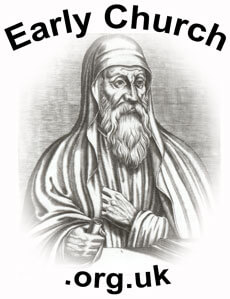Montanism: Heresy Or Healthy Revival?
Robert I Bradshaw
Theology on the Web helps over 2.5 million people every year to find high quality theological resources that will help to equip them to serve God and to know Him better (2 Timothy 2:15). Like other websites that provide free services, it is dependent on donations to enable it to grow and develop and only 0.004% of visitors currently do so. If you would like to support this site, please use one of the options to the right of this message.
Introduction
It has been said with truth that a perfect historian of secular events will never be found, how much less hope can we entertain that the vast field of ecclesiastical history will ever find a really successful explorer.(1)
John De Soyres’ statement is never more true than when applied to the Montanist movement. The main problem that scholars find when discussing this subject is the shortage of information, and the biased nature of the existing sources.
Tertullian (c. 153-225 AD) is virtually the only writer to support the Montanist movement. Following his conversion to Montanism late in life he was condemned by later writers. The Seven Books Against The Church In Defence Of Montanism that he wrote have, sadly, been lost, leaving us with incidental references gleaned from his other works.(2)
About twenty Montanist prophecies have been preserved by Epiphanius,(3) writing in the fourth century, but his objectivity in their selection is open to question. Douglas notes that "Epiphanius is reckoned to be a poor authority on almost any subject."(4) Probably the two most valuable sources are Tertullian and the Anonymous contemporary of Montanus, quoted in Eusebius’s Church History.(5)
A Brief History of Montanism
As the Christian Church grew in numbers and prosperity the fire that had driven it on began to burn low.(6) The heresies of Marcion and the Gnostics had been halted, but only at a cost. Increasing moral laxity and formalism produced fertile ground for a re-assertion of holiness and freedom in the Holy Spirit (things that the Gnostics had depreciated).(7) Montanism is often described as a reaction against the increasing authority of the Bishops,(8) however this is not wholly correct, for the Montanists appear to have seen themselves as a step forward, rather than a rear-guard action.(9)
Montanism derives its modern name from its founder Montanus, a Phrygian(10) and native of Ardabau, "a village in Mysia" [sic](11) (near the Phrygian border)(12). According to Jerome(13) (342-420) he was a priest of Cybele, "the Mother of the gods..." This would mean that he had been castrated - as the wild and barbarous worship of Cybele had to be performed by ‘half-men’.(14) Many see a link between the enthusiastic nature of Phrygian worship and the rise of Montanism. However, the link is tenuous and it appears that Jerome may well have accused Montanus of formerly being a priest of Cybele to further discredit his teachings. As John De Soyres points out, "all that we can be certain about Montanus is that he existed," all other information about him are rumours on which it is impossible to pass judgement.(15)
Until the middle of the late fourth century the movement was known as the Kataphrygians (according to Eusebius, Epiphanius of Cyprus and John of Damascus),(16) a name derived from its place of origin. The date at which Montanus began to proclaim his ‘New Prophecy’ is also widely disputed. Estimates range from 126,(17) 130,(18) 156,(19) to 171-172.(20) De Soyres opts for the earliest date because a movement starting in an obscure village in 172 is unlikely to have spread so fast as to be condemned in Rome the following year.(21) This notwithstanding most modern scholars opt for the later date of around 170.(22)
The ‘New Prophecy’ that Montanus proclaimed grew rapidly in popularity. He was joined by Prisca and Maximilla, two women of rank(23) who left their husbands and families to follow him.(24) Prisca succeeded Montanus as the main Prophet, and later Maximilla followed her, until her death in 179.(25) The fact the leaders were women seems to have been an additional upsetting factor to the Catholic bishops, who said that they were demon-possessed and attempted to exorcise them.(26)
The movement spread throughout Asia Minor, Thrace, Rome, Gaul and Africa.(27) In 177 (during the persecution of Marcus Aurelius)(28) the imprisoned believers at Lyons sent a letter to the churches of Asia and Phrygia, and despatched Irenaeus as their messenger to Eleutherus, Bishop of Rome.(29) They urged him not to quench the Spirit by taking unduly severe action against the Montanists. It appears that the church in Lyons may have been founded through Phrygian evangelisation.(30) At the end of the second century Montanism reached the province of Africa, where in 206,(31) it captured its greatest convert - Tertullian of Carthage. Most writers agree that the great champion of orthodoxy must have seen something good in the Montanists to throw in his lot with them.(32)
With the spread of Montanism came increasing condemnation and persecution from the Catholic church. It was anathematised by several Asiatic synods before 193.(33) In 202(34) the Sabellian Praxeas persuaded the Bishop of Rome - either Victor or Zephyrinus(35) - to condemn them, despite protests from Tertullian.(36) A synod held at Iconium at the time of Firmillian (d. 268) ordered that converts from Montanism be re-baptised, likewise the later 7th Canon of Constantinople (381) treated them as they would Pagans.(37) Persecution continued in the fourth century under Constantine (c.274-337) until the movement was finally obliterated in the fifth century.
The ‘New Prophecy’
The birth of the ‘New Prophecy’ can be traced to Montanus’s baptism, when he was filled with the Holy Spirit and announced that:
As the dispensation of the Father had given way to the dispensation of the Son, so the dispensation of the Son had now given place to the dispensation of the Holy Spirit, for [he maintained] Christ’s promise of the Paraclete had now been fulfilled.(38)
Closely connected with this was an expectation of the impending Second Advent of Christ and the establishment of the Millennial rule on Earth.(39) The prophesies were given in a state of frenzy and in the first person, which caused many to question their origin. An example would be: "I am neither angel nor ambassador, but I God and Father, who am come,"(40) which not surprisingly worried many Catholic Bishops. Yet clearly at that time prophecy was not unknown in the churches, although it was becoming less common. The form in which the prophecies came was also not unknown, as similar terms were used by Athenagoras of Athens and Theophilus of Antioch when referring to Old Testament prophets: "The prophets went around in bands, frenzied and prophesying to the sound of music (1 Sam. 10:5-13; 19:18-24). Their ecstasies fired them with zeal for Yahweh."(41) Justin Martyr denied that the prophet did anything else but speak the actual words - that is he had no control on the prophecy. It was only later in the third century that this view was rejected and Epiphanius laid down the criteria that prophecy must be conscious and intelligent.(42)
Much has been made of the prophecy attributed to Prisca that the New Jerusalem would descend on Pepuza in Phrygia,(43) but again there is no evidence to suggest that this was a literal belief, as it may well have referred to a present rather than a future event.(44) Tertullian believed that the Holy City would soon descend on the site of the old Jerusalem.(45) With the eager expectation of the Kingdom came an unhealthy tendency to court martyrdom.(46) Some of their opponents jibed that no Montanist had actually faced death for the Faith,(47) but it is almost certain that Perpetua and Felicita were Montanists when they died in c. 207 at Carthage.(48)
Bigg maintains that they were not only orthodox in doctrine, but that they contributed to the formation of the later Creed. "They were the first to enunciate the ‘homoousion’ and they were also the first to bestow the title ‘God’ upon the Holy Spirit."(49) Their main offence was that they were too far ahead of their time.(50) Most modern scholars agree with Bigg that the Montanists were orthodox in belief and practice and only differed on the emphasis that they placed on certain aspects of their faith. In particular they were marked out by their asceticism (especially concerning fasting), in their attitude to marriage,(51) as well as in their moral rigorism.(52)
On the subject of fasting Hippolytus makes the following accusation: "But they introduce new fasts and festivals and the practice of eating dry things and radishes, pretending that the females [Prisca & Maximilla] have enjoined them."(53) By this time the orthodox church was fasting voluntarily on Wednesdays and Fridays, but the Montanists’ fasts were all compulsory, and lasted until nightfall.(54) Writing in De Jejunis Tertullian states that he only practised two weeks of xerophage(55) a year (Sabbaths and Lord’s Days excepted during that time).(56) Jerome’s accusation that they observed three Lents is probably a later fabrication.(57) Despite these restrictions, as Sherratt points out, "the fasts… were not unlike those which orthodox ascetics had long practised."(58)
At first the Montanists appear to have had the tendency to renounce marriage (e.g. Prisca & Maximilla and their families), but later their distinctive teaching took the form of a ban on second marriages, for ministers and laity alike.(59) Justifying this practice Tertullian wrote: "If Christ abrogated what Moses commanded because from the beginning it was not so why should not the Holy Spirit alter what Paul permitted."(60) Tertullian’s statement has led many scholars to conclude that the Montanists rejected Scripture in favour of their new revelations.(61) However, David Wright argues that there are insufficient grounds for such an assumption, though the Montanist rank and file "may have been guilty of extravagant reverence for the teachings of their prophetic leaders, treasuring them, and even appearing to exalt them above the Scriptures themselves."(62) Clearly Hippolytus was among those who gained such an impression.(63)
It is very likely that as the movement spread its teachings were modified and changed.(64) The Montanists certainly made what some at the time considered excessive use of the writings of John (with their many references to the Paraclete), to such an extent that some extreme Catholics began to doubt their authenticity.(65) F.F. Bruce notes somewhat dryly that this was an excessive price to pay for the maintenance of Catholic unity.(66)
Heresy or Healthy Revival?
Having traced the history of the movement, and discussed its teachings it is not easy to discover any one reason why they were considered heretics at the time. In doctrine they were orthodox, yet their over-emphasis of certain aspects of the Faith proved too much for the Catholic Bishops.(67) The Montanists do not appear to have been anti-hierarchical, but did give the Prophet more authority than was becoming the norm. F.F. Bruce points out that in the Catholic Church the challenge of doctrinal heresy had been countered by increasing the power of the Bishops. Ignatius serves as a good example of an early bishop who clearly believed in prophetic utterances, but in the way that he used them he limited their use in the wider church. His reason for doing this was that only the Bishops, the bastions of orthodoxy could truly be trusted to use the gift correctly.(68)
Coming into this arena the Montanist movement was treated with the subtlety of a steam-hammer and attacked as heretical and divisive. We have already seen that they were probably not heretics at all, but he second point requires further comment. It was the Catholic Church that expelled the Montanists officially. It is possible that this was partly in response to something that we see in Tertullian’s writings: he made a clear distinction between ‘soulish’ and ‘spiritual’ believers - implying a church within a church - and thus leading to spiritual pride among the immature. This ‘super-spirituality’ and their contempt for the Bishop’s condemnation(69) put them on a collision course that has left the Church poorer, shutting out the charismatic gifts for seventeen centuries.(70)
© 1992 Robert I. Bradshaw
References
(1) John De Soyres, Montanism And The Primitive Church. (Cambridge: Deighton, Bell & Co., 1877), 5.
(2) D.F. Wright, "Why Were The Montanists Condemned?" Themelios. (Sept. 1976): 15.
(3)Wright, 15; J. Stevenson, A New Eusebius: Documents Relating to the History of the Church to AD 337, 1957, rev. (London: SPCK, 1989), 107.
(4)G.C.M. Douglas, "Jepthtah," Jay P. Green, ed. Classic Bible Dictionary. (Indiana: Sovereign Grace Trust Fund, 1988), 613.
(5) See Stevenson, 102-108.
(6) F.F. Bruce, The Spreading Flame. (Exeter: Paternoster Press, 1964), 219.
(7) H.N. Bate, History Of The Church to A.D. 325, 2nd edn. (London: Rivingtons, 1943), 63.
(8) David Christie-Murray, A History of Heresy. (Oxford: OUP, 1990), 33.
(9) C. Bigg, The Origins Of Christianity. (Oxford: Clarendon Press, 1909), 185.
(11) The ‘Anonymous’ in Eusebius, History of the Church, 5.16.6; Stevenson, 102.
(12) De Soyres, 31.
(13) B. Sherratt, "Montanism," The Pentecostal. Vol. 1, No.1: 27.
(14) Sherratt, 27.
(15) Soyres, 31.
(16) F.F. Bruce, The Canon of Scripture. (Leicester: IVP, 1989), 167-168.
(17) De Soyres, 25-26.
(18) Sherratt, 27.
(19) Bate, 63; Bruce, Flame, 218; E.H.Broadbent, The Pilgrim Church, 2nd edn. (London: Pickering & Inglis, 1913), 12.
(20) S.G. Green, A Handbook Of Church History. (London: Religious Tract Society, 1913), 177; W.H.C. Frend, The Early Church. (London: SCM, 1982), 69; Christie-Murray, 34. T. D. Barnes, Tertullian: A Historical and Literary Study. (Oxford: Clarendon Press, 1971), 82.
(21) De Soyres, 29.
(22) Dennis E. Groh, "Montanism," Everett Ferguson, ed., Encyclopedia of Early Christianity. (New York: Garland, 1990), 622.
(23) Eusebius, History, 5.16.13; Sherratt, 27.
(24) Bruce, Flame, 219; Soyres, 34.
(25) Frend, 70.
(26) Bruce, Flame, 219.
(27) Broadbent, 12.
(30) Eusebius, History, 5.1.3; Stevenson, 34; Soyres, 40.
(31) Bruce, Flame, 219; Bruce, Canon, 180.
(32) Donald Gee, "Montanism," Redemption Tidings. (December, 1928): 5. Barnes, Tertullian, 83-84: "Tertullian’s later writings receive abuse and condemnation in subsequent ages. Many of the charges are unmerited. Tertullian did not leave the church wholly or mainly of his own accord. in the age of the Severi, the church was changing. it was becoming an established institution in which enthusiasm or direct communion with God presented a threat to the ecclesiastical hierarchy. Tertullian was the first great teacher of unimpeachable doctrinal orthodoxy who dared to enunciate an unpalatable truth: the church is not a conclave of bishops, but the manifestation of the Holy Spirit." Tertullian, Pud. 21.17.
(33) Bigg, 188.
(36) Tertullian, Against Praxeas, 1.4:
For after the Bishop of Rome had acknowledged the prophetic gifts of Montanus, Prisca and Maximilla, and in consequence of the acknowledgement, had bestowed his peace on the churches of Asia and Phrygia, he [Praxeas, already mentioned as having brought his heresy to Rome from Asia], by importunely urging false accusations against the prophets themselves, and insisting on the authority of the bishop’s predecessors in the See, compelled him to recall the pacific letter which he had issued, as well as to desist from his purpose of acknowledging the [said] gifts. By this Praxeas did a twofold service for the Devil at Rome; he drove away the Paraclete, and crucified the Father. Praxeas’ tares had been moreover sown, and had produced their fruit here also, while many were asleep in their simplicity of doctrine… we indeed, on our part, subsequently withdrew from the carnally minded on our acknowledgement and the maintenance of the Paraclete.
(37) De Soyres, 52; The 7th Canon of the Ecumenical Synod of Constantinople, cited in Soyres, 52:
The Montanists or Phrygians and the Sabellians, we receive as we do Pagans, namely, the first day we make them Christians, the second Catechumens, the third day we exorcise them by breathing thrice into their face and ears and make them continue a good while in the church and hear the Scriptures, and afterwards we baptise them.
(38) Bruce, Flame, 218.
(39) Philip Schaff, History of the Christian Church, Vol. 2, 1910. (Grand Rapids: Eerdmans, 1990 reprint), 424-425.
(40) Epiphanius, Heresies, 48.11; Stevenson, 107.
(41) Sherratt, 28.
(42) Sherratt, 29.
(43) Epiphanius, Haer. 49.1.
(44) Wright, 20.
(45) Broadbent, 13.
(46) Bruce, Flame, 219.
(47) The ‘Anonymous’ in Eusebius’ History, 5.16.12, 20-22.
(48) Broadbent, 13.
(49) Bigg, 194.
(50) Bigg, 194.
(51) Green, 177.
(52) Bruce, Flame, 219.
(53) Hippolytus, Refutation of all Heresies, lib. VIII, cap. 19. Cited in De Soyres, 80.
(54) Bigg, 191-192.
(55) The practice of eating only dry foods.
(56) Tertullian, De Jejuniis, cap. 15. Cited in De Soyres, 81.
(57) Jerome, Letter to Marcell, 41. Cited in De Soyres, 80.
(58) Sherratt, 28; De Soyres, 91; Bigg, 187.
(59) Bruce, Flame, 219; De Soyres, 83.
(60) Cited in De Soyres, 58.
(61) Sherratt, 28.
(62) Wright, 19.
(63) Hippolytus, Refutation, 8.19:
They are beguiled by two females whom they consider prophetesses… They pretend that these see certain things by means of the Paraclete in them. They implicitly believe what these utter, and give out what they learnt more from their revelation than from the Law, the Prophets and the Gospels.
(64) Bruce, Flame, 220.
(65) These became known as the Alogi - those who reject the Logos. Christie-Murray, 37, n.2.
(66) Bruce, Canon, 168-169.
(67) Christie-Murray, 35:
Although Montanus preached no doctrine heretical in itself - his heresy lay, as it so often does, in a lack of balance deriving from over-emphasis of some parts of faith and practice at the expense of others - nor was he accused by his enemies of doing so.… The fault of Montanism in the eyes of the orthodox was that it exalted itself above the official hierarchy of the church.
(68) Bruce, Flame, 217.
(69) Wright, 21.
(70) Wright, 21.









